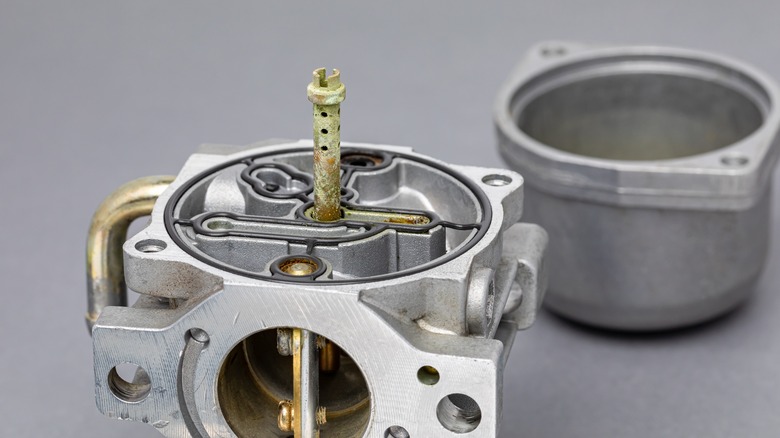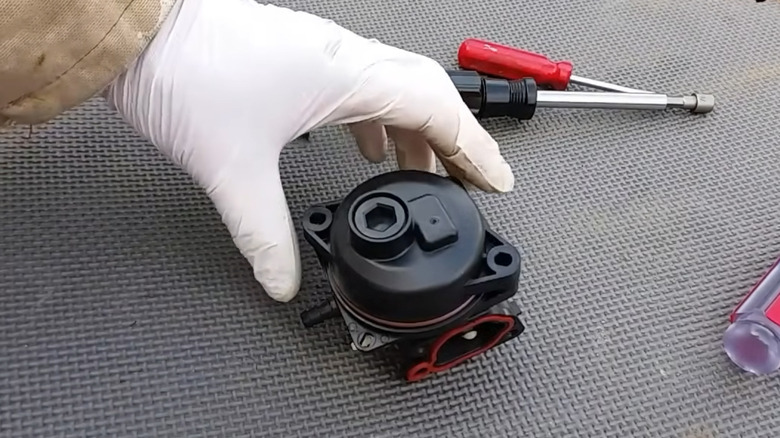The Quick And Simple Method For Cleaning Your Lawn Mower's Carburetor
We may receive a commission on purchases made from links.
Many small gasoline-powered equipment have a common problem lurking in wait for you — the dreaded, and almost inevitable, clogged carburetor. Fuel moves into an engine through a tiny orifice in a small brass part called the jet, and it takes almost nothing to block the way. That almost nothing includes gunk from old fuel, which is an easy thing to do when fuel is used in a machine that sits for months or longer, unused, and without a fuel stabilizer. Lawn mowers, garden equipment such as tillers, and gas generators that are infrequently used often fall prey to this issue. This is, incidentally, why gas is the one thing to check on your lawn mower before your first mow of the year, and it is a good case for using fuel stabilizer in your lawn mower.
If your lawn mower keeps dying when it's barely started, inexplicably won't start after a long period of disuse, or runs only in surges, you might very well have a clogged carburetor jet. One way to verify this with a surging engine is to apply the engine's choke while it's running. If this smoothes out the engine, your carburetor is probably clogged. The good news is that the cleaning is probably easier than you think.
All you need for a quick and effective carburetor cleaning is a couple of shop rags, a can of carburetor or brake cleaner, and a set of small engine orifice cleaning wires, which typically come in various gauges on a handle like a spark plug feeler gauge, similar to the LImeiy Carburetor Carbon Dirt Jet Remove Cleaner. You'll also need a wrench and a ratchet with sockets, usually 10mm and/or 13mm.
How to clean a small engine carburetor
You'll start by disassembling a few pieces, drilling down toward the carburetor's jet, the orifice that supplies fuel to be mixed with air. This might involve removing a plastic shroud from the engine, depending on the manufacturer and model, and will usually require removing the air filter and its housing so that you can access the carb. Clean everything well as you go, since you don't want dirty parts or hands in the picture once you get inside the carburetor. When you can see the carburetor's throat and choke plate, you're in business.
After placing a rag underneath to catch any spilled fuel, remove the float bowl (typically a pointed cone located below the carburetor) and begin cleaning everything with carburetor or brake cleaner. For the most part, this is as simple as spraying down the carburetor with the cleaner. If you need an abrasive, use wire brushes and compressed air. Be aware that the solvents in these cleaners don't mess around and can easily dissolve rubber and many plastics. Take particular care to clean the needle and needle seat, through which the carb draws fuel into the float bowl. Spray the tube into which the carburetor's jet is screwed with cleaner and push a wire from your set through it, adding cleaner as necessary until you can freely spray cleaner through the jet into the throat.
One common problem and one big improvement on the cleaning process
Here's where we must contend with one possibility outside of the normal process. If you have a recent Briggs & Stratton engine with a plastic carburetor, you can mostly clean it as usual, including using brake or carb cleaner. However, cleaning the jet can be tricky because these engines run very lean and have an extremely small bore jet that's very easily clogged. This has been reported many times in online forums and on YouTube. These tiny orifices are difficult to clean and nearly impossible to keep clear of obstructions. A common approach is to drill out the orifice, enlarging it with a .020-inch wire drill bit on a pin vise. You can buy a Zhehao Metal Pin Vise Hand Drill Micro Twist Set on Amazon for $11.99. Note that enlarging the orifice might eliminate the blockages, but it might also cause the richer fuel mixture to foul spark plugs. But you certainly won't foul any plugs if the engine won't run.
Another approach to cleaning the plastic carburetors, and in fact, all small engine carburetors, is to use an ultrasonic bath for cleaning carburetor parts. A heated bath, such as the ONEZILI Three-Liter Ultrasonic Cleaner, is large enough to clean carburetors and many other items — commonly jewelry — thoroughly, using chemicals as mild as dish soap and water. Alternatively, you can go another way and use a dedicated carburetor and parts cleaner with a basket, like Berryman Chem Dip, which will do a reasonably good job overnight.


